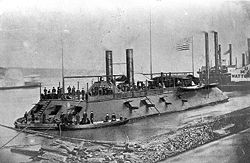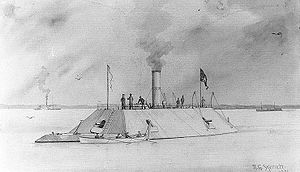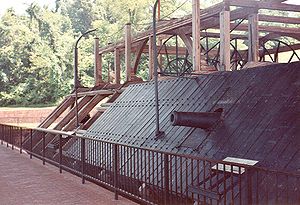
Casemate ironclad
Encyclopedia

American Civil War
The American Civil War was a civil war fought in the United States of America. In response to the election of Abraham Lincoln as President of the United States, 11 southern slave states declared their secession from the United States and formed the Confederate States of America ; the other 25...
. Compared to the traditional ironclad warship
Ironclad warship
An ironclad was a steam-propelled warship in the early part of the second half of the 19th century, protected by iron or steel armor plates. The ironclad was developed as a result of the vulnerability of wooden warships to explosive or incendiary shells. The first ironclad battleship, La Gloire,...
, the casemate ironclad does not have its cannons in an armored gun deck, but instead has a casemate
Casemate
A casemate, sometimes rendered casement, is a fortified gun emplacement or armored structure from which guns are fired. originally a vaulted chamber in a fortress.-Origin of the term:...
structure (often sloped) on the main deck housing the guns. As the guns are carried on the top on the ship yet still fire through fixed gunports, the casemate ironclad is seen as an intermediate stage between the traditional broadside frigate and the modern warships.


Freeboard (nautical)
In sailing and boating, freeboardmeans the distance from the waterline to the upper deck level, measured at the lowest point of sheer where water can enter the boat or ship...
, upon which an armored casemate
Casemate
A casemate, sometimes rendered casement, is a fortified gun emplacement or armored structure from which guns are fired. originally a vaulted chamber in a fortress.-Origin of the term:...
structure was built. This casemate housed anywhere from 2 to 15 cannons, most of them in broadside positions as in classical warships. The casemate was heavily armored (later confederate ironclads porting three layers of 2" steel) and was sloped to deflect direct hits (a 35 degree angle quickly becoming standard). Armor was also applied to the part of the hull above the waterline. The casemate was often box shaped, with octagon shapes appearing in the later stages of the war. From the top of the casemate protruded an armored lookout structure that served as a pilothouse
Pilothouse
A pilothouse or pilot-house is a glass-enclosed room from which a ship is controlled by the ship's pilot. The pilothouse also is known as the wheelhouse....
, and one or two smokestacks.
The casemate ironclad being steam driven, either by screws or by paddle-wheels, it did not need sails or masts, although sometimes, when not in combat, temporary pulley-masts, flagpoles, davit
Davit
A davit is a structure, usually made of steel, which is used to lower things over an edge of a long drop off such as lowering a maintenance trapeze down a building or launching a lifeboat over the side of a ship....
s, and awnings were added. Inside the casemate, the guns were housed in one continuous deck. Unlike with turret ironclads
Monitor (warship)
A monitor was a class of relatively small warship which was neither fast nor strongly armoured but carried disproportionately large guns. They were used by some navies from the 1860s until the end of World War II, and saw their final use by the United States Navy during the Vietnam War.The monitors...
, the guns had to fire through fixed gunports and therefore aiming was done by moving the gun relative to the gunport. This was labor intensive and often up to 20 men were needed to load, aim, fire, and clean a gun, and even with this manpower the firing rate was no better than one shot per five minutes.
Although the Union
Union (American Civil War)
During the American Civil War, the Union was a name used to refer to the federal government of the United States, which was supported by the twenty free states and five border slave states. It was opposed by 11 southern slave states that had declared a secession to join together to form the...
successfully used a fleet of casemate ironclad riverboats in their Mississippi Campaign
Mississippi River campaigns in the American Civil War
The Mississippi campaign was an economic problem created by the Union during the American Civil War in which Union Army troops, helped by gunboats and river ironclads took control over the Mississippi River, therefore virtually splitting the Confederate territory in two while also controlling the...
, the casemate ironclad is mostly associated with the Confederacy
Confederate States of America
The Confederate States of America was a government set up from 1861 to 1865 by 11 Southern slave states of the United States of America that had declared their secession from the U.S...
. This is partly due to the Battle of Hampton Roads
Battle of Hampton Roads
The Battle of Hampton Roads, often referred to as either the Battle of the Monitor and Merrimack or the Battle of Ironclads, was the most noted and arguably most important naval battle of the American Civil War from the standpoint of the development of navies...
, in which the Union
Union (American Civil War)
During the American Civil War, the Union was a name used to refer to the federal government of the United States, which was supported by the twenty free states and five border slave states. It was opposed by 11 southern slave states that had declared a secession to join together to form the...
turreted ironclad USS Monitor
USS Monitor
USS Monitor was the first ironclad warship commissioned by the United States Navy during the American Civil War. She is most famous for her participation in the Battle of Hampton Roads on March 9, 1862, the first-ever battle fought between two ironclads...
and the Confederate
Confederate States of America
The Confederate States of America was a government set up from 1861 to 1865 by 11 Southern slave states of the United States of America that had declared their secession from the U.S...
casemate ironclad CSS Virginia
CSS Virginia
CSS Virginia was the first steam-powered ironclad warship of the Confederate States Navy, built during the first year of the American Civil War; she was constructed as a casemate ironclad using the raised and cut down original lower hull and steam engines of the scuttled . Virginia was one of the...
(sometimes called the Merrimack
USS Merrimack (1855)
USS Merrimack was a frigate and sailing vessel of the United States Navy, best known as the hull upon which the ironclad warship, CSS Virginia was constructed during the American Civil War...
) dueled, giving rise to the popular notion that "The North had Monitors while the South had (casemate) ironclads". In effect, the Confederacy
Confederate States of America
The Confederate States of America was a government set up from 1861 to 1865 by 11 Southern slave states of the United States of America that had declared their secession from the U.S...
concentrated its efforts on casemate ironclads as a means to harass the Union blockade of their ports, but this was a choice dictated by available technology and materials rather than by confidence in the possibilities of this type.

